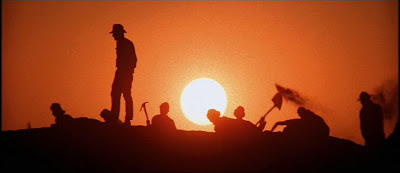
I haven’t gotten around to re-watching the entire Indiana Jones trilogy yet, but I am seeing the new film tomorrow, so I figured I might as well get around to posting some of the Indy-themed things that I’ve been sitting on.
First and foremost: The character’s ambivalent relationship with real-world archaeologists. One of the reasons my wife and I like Raiders of the Lost Ark (1981) better than the other two films is that it is the only film in which we see Indiana Jones doing real archaeology, with surveying equipment and picks and shovels and whatnot. True, he may be just a treasure hunter, and he may be neglecting some of the more finely-detailed work that modern archaeologists are supposed to do — noting where coins and bits of broken pottery were found on carefully plotted grids, etc. — but at least he’s not just running around like a spy. He’s actually doing the work. And I actually get a kick from sequences like the one below, where we see the archaelogical dig from Indy’s perspective, and we see how following the calculations leads him past a few other spots before it takes him to the actual spot where he needs to start digging:
Anyway, I bring this all up now because a few news stories have popped up that address the question of what real archaeologists think of Indy. First, there was this bit from the Associated Press:
Though he preaches research and good science in the classroom, the world’s most famous archaeologist often is an acquisitive tomb raider in the field with a scorched-earth policy about what he leaves behind. While actual archaeologists like the guy and his movies, they wouldn’t necessarily want to work alongside him on a dig.
Indy’s bull-in-a-china-shop approach to archaeology will be on display again May 22 with “Indiana Jones and the Kingdom of the Crystal Skull,” in which he’s sure to rain destruction down on more historic sites and priceless artifacts.
Real experts in antiquities acknowledge that the movies are pure fiction that present archaeology as blockbuster adventure, yet they cannot help but cringe at the way Indy manhandles the ancient world.
“There are codes of ethics in archaeology, and I don’t think he would be a member. Not in good standing, anyway,” said Mark Rose, online editorial director for the Archaeological Institute of America. . . .
The reality of archaeological field work is not a lone hero dashing into hidden chambers with a bullwhip and a pistol and coming away with a priceless relic. It’s large groups of academics and students painstakingly sifting through grids to retrieve artifacts as mundane as pottery fragments.
“It is rather adventurous in a way, because for the most part, you’re going to some exotic country and delving into their past. But it’s not an adventure with a whip and chasing bad guys and looking for treasure,” said Bryant Wood, an archaeologist with Associates for Biblical Research.
“You’re working at one site tediously, probably for many, many years and spending more time processing the finds and writing reports than you do actually digging at the site. But that wouldn’t make for a very good story, spending 70 percent of the time in a library.” . . .
Other than Indy’s brief classroom scenes, the closest thing to authentic archaeology in the “Indiana Jones” flicks is done by the bad guys, whose elaborate, systematic digs in “Raiders” resemble actual excavations.
“Not a whole lot of what we know as archaeology goes on in these movies, except what the Nazis do. They seem to be doing some real archaeological work,” said Walsh, who wrote the cover story in the May-June issue of Archaeology magazine examining the real history of crystal skulls featured in the new “Indiana Jones” movie. . . .
The final paragraphs of the AP piece raise an interesting point that might actually be redressed by the new film:
“Indiana Jones” and other productions such as “The Mummy” and “Lara Croft: Tomb Raider” flicks benefit archaeology by getting general audiences thinking and talking about the ancient world, said Bob Murowchick, associate professor of archaeology at Boston University.
But the movies emphasize the tomb-raiding aspect, leaving the impression that artifacts are there for the taking by whoever stumbles on them first, he said.
“The one thing we do worry quite a bit about is the looting aspect, because archaeological looting is really a serious issue,” Murowchick said. “This kind of glorifying of breaking into a tomb and snagging a crystal this or golden that feeds into the notion that these are valuable objects, and we should all get it while we can.”
As it happens, the newest trailers for Indiana Jones and the Kingdom of the Crystal Skull make the point that one can control the power of the crystal skull only by taking it back to the lost city or temple from whence it came. That suggests a somewhat different trajectory from, say, the opening scene in Raiders, where Indiana Jones essentially stole an idol from a South American altar. And come to think of it, the narrative thrust of Temple of Doom (1984) is that Indy ultimately brings the Sankara Stone back to the village that needs it, while Last Crusade (1989) makes the point that the Holy Grail really cannot be removed from the general place where Indy finds it; in both films, Indy ultimately discovers something better than “fortune and glory”.
Anyway, two days after running that story, the AP ran another one in which they revealed that Harrison Ford, the star of the Indiana Jones series, has been elected to the board of directors for the Archaeological Institute of America — the same outfit that publishes the aforementioned Archaeology magazine! And, as Christopher Campbell notes, that is also the same outfit where Mark Rose works — Rose being the guy who said that Indy would not “be a member . . . in good standing, anyway” of the archaeological community. Oh, the irony!
Turning to other matters, the Associated Press reports that “Few of today’s crystal skulls can be documented any further back than the 1860s, when Europe was swept by a rage for pre-Hispanic ‘relics'” — interestingly, the Archaeology magazine article linked above indicates that the gold idol stolen by Indy at the beginning of Raiders is probably also based on a 19th-century forgery — but some people believe in them very strongly anyway. Meanwhile, a real-life crystal skull has been stolen from a New Age store in California.
The Daily Telegraph, for its part, gives us a sense of just how “wacky” the new movie could have been, if George Lucas had had his way:
If George Lucas had had his way the new Indiana Jones movie would be called “Indiana Jones and the Saucer Men From Mars”, and the iconic archaeologist adventurer would be battling space aliens instead of communists.
But both Harrison Ford and Steven Spielberg firmly rejected the idea. So Lucas went back to the drawing board, and the wrangling between these three powerful, opinionated men continued for the next 10 years or so.
“There was a point where I thought George and I would never agree on the story, and I was fine with that,” recalls Spielberg. “George and I are best friends, and we always argue, and we always debate. That’s been the nature of our relationship since we met in 1967.”
Harrison Ford, who at the age of 65 has now donned Indiana Jones’s fedora and leather jacket for the fourth time, says drily: “It takes time to get Steven, George and me on the same page. George is very stubborn with his ideas.” . . .
The Associated Press echoes that bit about the “saucer men from Mars” in its own story on the shroud of secrecy surrounding this movie. So Lucas certainly wasn’t kidding when he said he was going to go all Phantom Menace on this movie. One key distinction, though, is that to get the new Indiana Jones movie made, Lucas had to accommodate other people to some degree. On the Star Wars prequels (1999-2005), Lucas was surrounded by nothing but yes-men, but on the Indiana Jones franchise, Lucas has to contend with a fellow billionaire movie mogul, i.e. Spielberg, and with a strong leading man who is absolutely essential to the continuation of the franchise, i.e. Ford.
Then again, Fox News and the MTV Movies Blog report that Lucas is thinking of maybe continuing the franchise “with Shia LaBeouf’s Mutt Williams as the main character” and “Indy [relegated] to sidekick status, a la Sean Connery in ‘Last Crusade.'” Eep.















